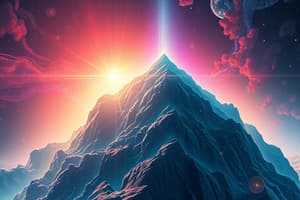Podcast
Questions and Answers
Describe two ways atoms can become excited.
Describe two ways atoms can become excited.
Atoms can become excited through collisions with other atoms or electrons or by absorbing a photon.
Which energy transition requires the greatest amount of energy for an electron in a helium atom?
Which energy transition requires the greatest amount of energy for an electron in a helium atom?
- Second to third energy level
- First to third energy level
- First to second energy level
- First to fourth energy level (correct)
Which energy transition requires the least amount of energy for an electron in a helium atom?
Which energy transition requires the least amount of energy for an electron in a helium atom?
- Second to third energy level
- First to second energy level (correct)
- First to fourth energy level
- First to third energy level
When an electron returns to its original energy level, which transition emits a photon of higher frequency?
When an electron returns to its original energy level, which transition emits a photon of higher frequency?
What kind of spectrum does a neon light produce?
What kind of spectrum does a neon light produce?
What kind of spectrum does a hot, dense object that is surrounded by a cooler gas produce?
What kind of spectrum does a hot, dense object that is surrounded by a cooler gas produce?
What kind of spectrum does a hot, dense object produce?
What kind of spectrum does a hot, dense object produce?
What kind of spectrum does a hot, low-density gas produce?
What kind of spectrum does a hot, low-density gas produce?
How do astronomers know if there is sodium on the Sun?
How do astronomers know if there is sodium on the Sun?
Flashcards are hidden until you start studying
Study Notes
Energy Excitation of Atoms
- Atoms gain energy through collisions with other atoms or electrons.
- Photon absorption is another method for atoms to become excited energetically.
Helium Atom Energy Transitions
- Transition from the first to the fourth energy level requires the greatest energy.
- Transition from the first to the second energy level requires the least energy.
- Returning from the fourth to the first energy level emits a photon with the highest frequency.
- Transitioning from the second to the first energy level emits a photon with the lowest frequency.
Spectra Produced by Neon Lights
- Neon lights create an emission spectrum due to low-density neon gas ignited by electric current.
Spectra from Hot Dense Objects
- A hot, dense object surrounded by cooler gas produces an absorption spectrum, as per Kirchhoff's rule III.
Continuous Spectrum from Dense Objects
- A hot, dense object alone generates a continuous spectrum, according to Kirchhoff's rule I.
Emission Spectrum from Low-Density Gas
- A hot, low-density gas produces an emission spectrum, in accordance with Kirchhoff's rule II.
Astronomical Identification of Elements
- Astronomers determine the presence of elements like sodium on the Sun by comparing its spectral lines to known spectra on Earth.
- Each element has a unique spectral signature, aiding in the identification of various elements in celestial bodies.
Studying That Suits You
Use AI to generate personalized quizzes and flashcards to suit your learning preferences.




